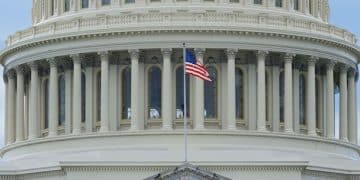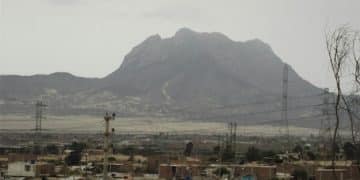US Response to Yemen’s Humanitarian Crisis: An In-depth Analysis

The US addresses the humanitarian crisis in Yemen through a multifaceted approach including diplomatic efforts, humanitarian aid, and targeted sanctions, striving to alleviate suffering and foster a path towards sustainable peace and stability.
The **US addressing the humanitarian crisis in Yemen** involves a complex interplay of diplomatic, financial, and political strategies. Understanding these efforts requires a careful examination of the ongoing challenges and the various avenues through which the US is attempting to mitigate suffering and foster stability in the region.
Understanding the Yemen Humanitarian Crisis
The humanitarian crisis in Yemen is one of the worst in the world, marked by widespread food insecurity, disease, and displacement. This complex emergency is a result of years of conflict, economic collapse, and a breakdown of essential services.

The ongoing conflict between the Yemeni government, supported by a Saudi-led coalition, and the Houthi rebels has had a devastating impact on the civilian population. Millions of people are in need of humanitarian assistance and protection.
Key Factors Contributing to the Crisis
Several factors have converged to create the dire situation in Yemen. Understanding these elements is crucial to grasping the scope of the challenge.
- Conflict and Violence: The ongoing armed conflict has directly resulted in casualties, displacement, and destruction of infrastructure.
- Economic Collapse: Years of conflict have crippled the Yemeni economy, leading to widespread poverty and unemployment.
- Breakdown of Essential Services: The conflict has disrupted access to healthcare, water, and sanitation, increasing the risk of disease outbreaks.
- Food Insecurity: Yemen is heavily reliant on imports for food, and the conflict has disrupted supply chains, leading to widespread hunger and malnutrition.
The crisis is further exacerbated by restrictions on humanitarian access, making it difficult for aid organizations to reach those in need. The lack of funding for humanitarian operations also poses a significant challenge.
In summary, the humanitarian crisis in Yemen stems from a combination of violent conflict, economic decline, and the collapse of essential services, creating a dire situation for millions of Yemenis.
US Diplomatic Efforts in Yemen
Diplomacy is a cornerstone of the US approach to the humanitarian crisis in Yemen. The US government has been actively engaged in efforts to mediate a resolution to the conflict and promote a peaceful transition.
These diplomatic efforts aim to bring the warring parties to the negotiating table and address the underlying causes of the conflict. The US also works closely with regional partners and international organizations to support these efforts.
US Engagement in Peace Negotiations
The US has played a key role in facilitating peace talks between the Yemeni government and the Houthi rebels. This engagement includes providing diplomatic support, mediating between the parties, and encouraging compromise.
While progress has been slow and setbacks have been frequent, the US remains committed to finding a political solution to the conflict. This commitment is reflected in the sustained diplomatic engagement of US officials and envoys.
- Supporting UN-led Mediation: The US actively supports the efforts of the United Nations Special Envoy for Yemen to mediate a ceasefire and political settlement.
- Engaging with Regional Actors: The US works closely with countries like Saudi Arabia and Oman to promote de-escalation and dialogue.
- Promoting Inclusive Political Process: The US encourages the inclusion of diverse voices, including women and civil society, in the peace process.
Despite the challenges, US diplomatic efforts have helped to prevent further escalation of the conflict and create opportunities for dialogue. The US continues to advocate for a comprehensive political solution that addresses the needs of all Yemenis.
Overall, US diplomatic efforts are crucial to fostering a peaceful resolution to the conflict in Yemen, addressing the root causes of the humanitarian crisis and promoting lasting stability.
Humanitarian Assistance Provided by the US
Humanitarian assistance is a critical component of the US response to the crisis in Yemen. The US is one of the largest donors of humanitarian aid to Yemen, providing funding for food, water, healthcare, and other essential services.
This assistance is delivered through a variety of channels, including international organizations, NGOs, and UN agencies. The US works closely with these partners to ensure that aid reaches those who need it most.

Areas of Focus for US Humanitarian Aid
US humanitarian aid to Yemen is targeted at addressing the most pressing needs of the population. This aid covers a wide range of sectors, including food security, health, and water.
- Food Assistance: The US provides significant funding for food aid programs that provide life-saving assistance to millions of Yemenis.
- Healthcare Support: The US supports healthcare facilities and programs that provide essential medical services, including maternal and child health.
- Water and Sanitation: The US funds projects that improve access to clean water and sanitation, reducing the risk of disease outbreaks.
- Protection Assistance: The US supports programs that protect vulnerable populations, including women and children, from violence and exploitation.
In addition to direct aid, the US also supports efforts to improve humanitarian access and coordination. This includes advocating for the removal of obstacles to aid delivery and working with partners to strengthen coordination mechanisms.
In conclusion, US humanitarian assistance plays a vital role in alleviating suffering and providing essential services to the people of Yemen, addressing the immediate needs caused by the ongoing crisis.
Targeted Sanctions and Counter-Terrorism Measures
The United States employs targeted sanctions and counter-terrorism measures as part of its broader strategy in Yemen. These tools aim to promote accountability, disrupt illicit activities, and prevent the flow of resources to groups that undermine peace and stability.
Sanctions are imposed on individuals and entities that are involved in human rights abuses, corruption, or activities that threaten the peace, security, or stability of Yemen. Counter-terrorism measures target groups like al-Qaeda in the Arabian Peninsula (AQAP) and ISIS-Yemen.
Objectives of Sanctions and CT Measures
The implementation of sanctions and counter-terrorism measures serves several key objectives aimed at fostering a more stable and secure environment in Yemen.
The objectives include:
- Promoting Accountability: Sanctions hold individuals and entities accountable for their actions, sending a message that impunity will not be tolerated.
- Disrupting Illicit Activities: Sanctions and CT measures disrupt the flow of resources to groups that engage in violence, corruption, or terrorism.
- Supporting Peace Efforts: By targeting those who undermine peace, these tools can create incentives for constructive engagement in the political process.
However, The US carefully calibrates these measures to minimize unintended consequences and avoid exacerbating the humanitarian situation. Humanitarian exemptions are included in sanctions regimes to ensure that aid can continue to flow to those in need.
In summary, targeted sanctions and counter-terrorism measures are important tools for promoting accountability and disrupting illicit activities in Yemen, contributing to broader efforts to achieve peace and stability, while minimizing harm to the civilian population.
Challenges and Criticisms of US Policy
While the US has made significant contributions to addressing the humanitarian crisis in Yemen, its policies have also faced challenges and criticisms. These include concerns about the effectiveness of aid, the impact of sanctions, and the role of the US in the broader conflict.
Addressing these challenges and criticisms requires a careful assessment of the US approach and a willingness to adapt policies to improve outcomes. This includes strengthening aid effectiveness, minimizing unintended consequences, and promoting a more inclusive and sustainable approach to peacebuilding.
Common Critiques
Several critiques of US policy have emerged from various corners, raising important questions about the impact and effectiveness of the US approach.
The popular critiques include:
- Effectiveness of Aid: Some critics argue that US aid is not reaching those who need it most due to corruption, diversion, and bureaucratic obstacles.
- Impact of Sanctions: Concerns have been raised about the unintended consequences of sanctions, including their impact on the Yemeni economy and access to essential goods.
- Role in the Conflict: The US has faced criticism for its support of the Saudi-led coalition, which some argue has exacerbated the conflict and contributed to the humanitarian crisis.
Another challenge includes the difficulty of navigating the complex political landscape in Yemen. The fragmentation of power and the proliferation of armed actors make it difficult to implement effective policies and achieve lasting results.
In conclusion, addressing the challenges and criticisms of US policy in Yemen requires a commitment to transparency, accountability, and a willingness to learn from experience. By adapting its approach and working closely with partners, the US can improve the effectiveness of its efforts and contribute to a more sustainable and equitable solution to the crisis.
The Future of US Engagement in Yemen
Looking ahead, the future of US engagement in Yemen will likely depend on a number of factors, including the evolving political and security situation, the humanitarian needs, and the broader regional context. The US has the opportunity to play a constructive, but with a careful and planned approach.
A long-term vision for US engagement in Yemen should prioritize inclusive peacebuilding, resilience, and sustainable development. This requires addressing the underlying causes of the conflict, promoting good governance, and investing in the economic and social well-being of the Yemeni people.
Potential Avenues for Future Engagement
Several avenues exist for the US to enhance its engagement and contribute to positive change in Yemen.
These incluse;
- Increased Humanitarian Support: Continued and expanded humanitarian assistance will be essential to meet the urgent needs of the Yemeni population.
- Supporting Peacebuilding Initiatives: The US can play a more active role in supporting local peacebuilding initiatives that promote reconciliation and social cohesion.
- Promoting Economic Recovery: Investing in economic recovery and job creation can help to address the root causes of poverty and instability.
The US should also prioritize diplomatic efforts to resolve the conflict and support a transitional government. This government should be inclusive and representative of all segments of Yemeni society.
In summary, the future of US engagement in Yemen presents both challenges and opportunities. By adopting a long-term vision, prioritizing inclusive peacebuilding, and working closely with partners, the US can contribute to a more stable, prosperous, and resilient Yemen.
| Key Point | Brief Description |
|---|---|
| 🤝 Diplomatic Efforts | US engages in peace negotiations to resolve the conflict. |
| 💰 Humanitarian Aid | US provides funding for food, water, healthcare, and other essentials. |
| 🎯 Targeted Sanctions | Sanctions are imposed on those undermining peace efforts. |
| 🛡️ Counter-Terrorism | Measures target groups like AQAP and ISIS-Yemen. |
Frequently Asked Questions (FAQ)
▼
Delivering aid is difficult due to ongoing conflict, restrictions on access, and infrastructure damage, hindering aid organizations from reaching those in need.
▼
The US works with trusted partners, monitors aid distribution, and conducts audits to ensure aid reaches intended beneficiaries, and minimizes diversion and corruption.
▼
The US has expressed concerns about the coalition’s actions, advocating for minimizing civilian casualties and supporting a peaceful resolution to the conflict.
▼
The US actively supports UN-led mediation efforts, engages with regional actors, and promotes inclusive political processes to foster a peaceful resolution.
▼
Individuals can donate to reputable humanitarian organizations, advocate for policy changes, and raise awareness to support efforts to alleviate the crisis.
Conclusion
In conclusion, the US addresses the humanitarian crisis in Yemen through a combination of diplomatic engagement, humanitarian aid, targeted sanctions, and counter-terrorism measures. While challenges and criticisms remain, the US continues to strive for a comprehensive approach that alleviates suffering and promotes lasting peace and stability in Yemen.





